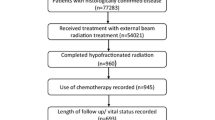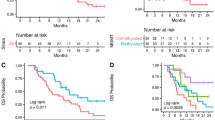Abstract
To assess the utilization and outcomes of adjuvant monotherapy with hypofractionated radiation (RT) among elderly patients not receiving traditional adjuvant chemoradiotherapy (cRT) for glioblastoma multiforme (GBM). A retrospective analysis using the National Cancer Data Base with GBM patients aged 65 years or older treated between 2005 and 2012 was conducted. Patients who underwent hypofractionated RT (40 Gy), conventional RT (60 Gy), chemotherapy, or best supportive care alone were included. Statistical methods included logistic regression for utilization and Cox regression for survival analysis. A total of 9556 patients were analyzed. On multivariate analysis (compared to those receiving conventional RT), patients more likely to be treated with hypofractionated RT were older (75–84 years old OR 2.05; p < 0.01 and ≥ 85 years old OR 3.32; p < 0.01), with a Charlson/Deyo score of 2 or higher (OR 1.80; p = 0.05), from communities > 50 miles from their treatment facility (50–100 miles OR 8.03; p < 0.01 and > 100 miles OR 7.16; p < 0.01), treated at an Academic/Research facility (OR 2.85; p = 0.04), and diagnosed between 2011 and 2012 (OR 4.15; p < 0.01). On Cox regression, hypofractionated RT (HR 0.65; p < 0.01), conventional RT (HR 0.60; p < 0.01), and chemotherapy alone (HR 0.69; p < 0.01) were all associated with decreased risk of death compared to no adjuvant therapy. Among patients receiving adjuvant treatment, utilization of hypofractionated RT increased from 7 to 19% during the study period. Among elderly patients with GBM not receiving cRT, the utilization of adjuvant monotherapy with hypofractionated RT has increased over time. Retrospective evidence suggests it may be better than best supportive care alone and as good as conventionally fractionated RT alone.


Similar content being viewed by others
References
Chakrabarti I, Cockburn M, Cozen W et al (2005) A population-based description of glioblastoma multiforme in Los Angeles County, 1974–1999. Cancer 104:2798–2806. https://doi.org/10.1002/cncr.21539
Kita D, Ciernik IF, Vaccarella S et al (2009) Age as a Predictive factor in glioblastomas: population-based study. Neuroepidemiology 33:17–22. https://doi.org/10.1159/000210017
Reardon D, Arvold N (2014) Treatment options and outcomes for glioblastoma in the elderly patient. CIA https://doi.org/10.2147/CIA.S44259
Stupp R, Mason WP, van den Bent MJ et al (2005) Radiotherapy plus concomitant and adjuvant temozolomide for glioblastoma. N Engl J Med 352:987–996. https://doi.org/10.1056/NEJMoa043330
Zarnett OJ, Sahgal A, Gosio J et al (2015) Treatment of elderly patients with glioblastoma. JAMA Neurol 72:589–588. https://doi.org/10.1001/jamaneurol.2014.3739
Roa W, Brasher PMA, Bauman G et al (2004) Abbreviated course of radiation therapy in older patients with glioblastoma multiforme: a prospective randomized clinical trial. J Clin Oncol 22:1583–1588. https://doi.org/10.1200/JCO.2004.06.082
Malmström A, Grønberg BH, Marosi C et al (2012) Temozolomide versus standard 6-week radiotherapy versus hypofractionated radiotherapy in patients older than 60 years with glioblastoma: the Nordic randomised, phase 3 trial. Lancet Oncol 13:916–926. https://doi.org/10.1016/s1470-2045(12)70265-6
Minniti G, Scaringi C, Lanzetta G, Terrenato I, Esposito V, Arcella A, Pace A, Giangaspero F, Bozzao A, Enrici RM (2015) Standard (60 Gy) or short-course (40 Gy) irradiation plus concomitant and adjuvant temozolomide for elderly patients with glioblastoma: a propensity-matched analysis. Radiat Oncol Biol 91:109–115. https://doi.org/10.1016/j.ijrobp.2014.09.013
Arvold ND, Cefalu M, Wang Y et al (2017) Comparative effectiveness of radiotherapy with vs. without temozolomide in older patients with glioblastoma. J Neurooncol 131:301–311. https://doi.org/10.1007/s11060-016-2294-7
Mak KS, Agarwal A, Qureshi MM, Truong MT (2017) Hypofractionated short-course radiotherapy in elderly patients with glioblastoma multiforme: an analysis of the National Cancer Database. Cancer Med 6:1192–1200. https://doi.org/10.1002/cam4.1070
Rusthoven CG, Koshy M, Sher DJ et al (2016) Combined-modality therapy with radiation and chemotherapy for elderly patients with glioblastoma in the temozolomide era. JAMA Neurol 73:821–828. https://doi.org/10.1001/jamaneurol.2016.0839
Patel CG, Yee AJ, Scullen TA et al (2014) Biomarkers of bone remodeling in multiple myeloma patients to tailor bisphosphonate therapy. Clin Cancer Res 20:3955–3961. https://doi.org/10.1158/1078-0432.CCR-14-0434
Keime-Guibert F, Chinot O, Taillandier L et al (2007) Radiotherapy for glioblastoma in the elderly. N Engl J Med 356:1527–1535. https://doi.org/10.1056/NEJMoa065901
Cabrera AR, Kirkpatrick JP, Fiveash JB, Shih HA, Koay EJ, Lutz S, Petit J, Chao ST, Brown PD, Vogelbaum M, Reardon DA et al (2016) Radiation therapy for glioblastoma: executive summary of an American society for radiation oncology evidence-based clinical practice guideline. Pract Radiat Oncol 6:217–225. https://doi.org/10.1016/j.prro.2016.03.007
Kano H, Kondziolka D, Flickinger JC et al (2012) Stereotactic radiosurgery for arteriovenous malformations, Part 3: outcome predictors and risks after repeat radiosurgery. J Neurosurg 116:21–32. https://doi.org/10.3171/2011.9.JNS101741
Wick W, Platten M, Meisner C et al (2012) Temozolomide chemotherapy alone versus radiotherapy alone for malignant astrocytoma in the elderly: the NOA-08 randomised, phase 3 trial. Lancet Oncol 13:707–715. https://doi.org/10.1016/s1470-2045(12)70164-x
Arvold ND, Tanguturi SK, Aizer AA et al (2015) Hypofractionated versus standard radiation therapy with or without temozolomide for older glioblastoma patients. Int J Radiat Oncol Biol Phys 92:384–389. https://doi.org/10.1016/j.ijrobp.2015.01.017
Professor TMA, Jain A, Degnin C et al (2016) Current patterns of care for patients with extensive stage small cell lung cancer: survey of US radiation oncologists on their recommendations regarding thoracic consolidation radiotherapy. Lung Cancer 100:85–89. https://doi.org/10.1016/j.lungcan.2016.08.005
Morris ZS, Wooding S, Grant J (2011) The answer is 17 years, what is the question: understanding time lags in translational research. JRSM 104:510–520. https://doi.org/10.1258/jrsm.2011.110180
Ward E, Jemal A, Cokkinides V et al (2004) Cancer disparities by race/ethnicity and socioeconomic status. CA Cancer J Clin 54:78–93. https://doi.org/10.3322/canjclin.54.2.78
Barnholtz-Sloan JS, Maldonado JL, Williams VL et al (2007) Racial/ethnic differences in survival among elderly patients with a primary glioblastoma. J Neurooncol 85:171–180. https://doi.org/10.1007/s11060-007-9405-4
Reblin M, Uchino BN (2008) Social and emotional support and its implication for health. Curr Opin Psychiatry 21:201–205. https://doi.org/10.1097/YCO.0b013e3282f3ad89
AlKhalili K, Chalouhi N, Tjoumakaris S et al (2014) Staged-volume radiosurgery for large arteriovenous malformations: a review. Neurosurg Focus 37:E20. https://doi.org/10.3171/2014.6.focus14217
Author information
Authors and Affiliations
Contributions
BB and CGP wrote the paper. CGP conducted the statistical analyses. AA and ETS reviewed the manuscript for content and form.
Corresponding author
Ethics declarations
Conflict of interest
All authors declare that they have no conflicts of interest.
Additional information
Brian Bingham and Chirayu G. Patel have contributed equally to the work.
Rights and permissions
About this article
Cite this article
Bingham, B., Patel, C.G., Shinohara, E.T. et al. Utilization of hypofractionated radiotherapy in treatment of glioblastoma multiforme in elderly patients not receiving adjuvant chemoradiotherapy: A National Cancer Database Analysis. J Neurooncol 136, 385–394 (2018). https://doi.org/10.1007/s11060-017-2665-8
Received:
Accepted:
Published:
Issue Date:
DOI: https://doi.org/10.1007/s11060-017-2665-8




